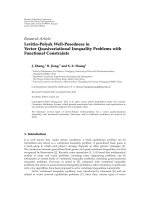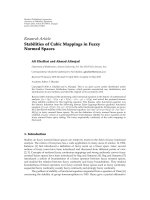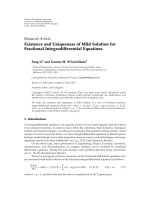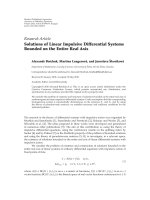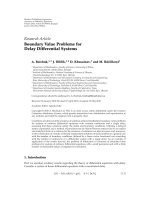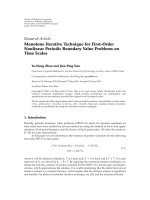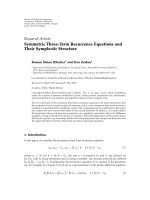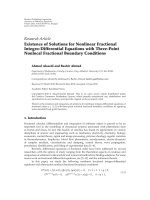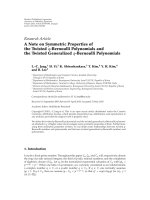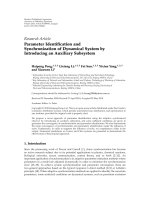Báo cáo sinh học: " Research Article Flexible Riser Monitoring Using Hybrid Magnetic/Optical Strain Gage Techniques through RLS Adaptive Filtering" ppt
Bạn đang xem bản rút gọn của tài liệu. Xem và tải ngay bản đầy đủ của tài liệu tại đây (15 MB, 14 trang )
Hindawi Publishing Corporation
EURASIP Journal on Advances in Signal Processing
Volume 2010, Article ID 176203, 14 pages
doi:10.1155/2010/176203
Research Article
Flexible Riser Monitoring Using Hybrid Magnetic/Optical Strain
Gage Techniques through RLS Adaptive Filtering
Daniel Pipa, S
´
ergio Morikawa, Gustavo Pires, Claudio Camerini, and Jo
˜
ao M
´
arcio Santos
Materials, Equipments and Corrosion Department (TMEC), Petrobras’ Research and Developme nt Center (CENPES),
Av. Hor
´
acio Macedo, 950. Cidade Universit
´
aria, 21941-915 Rio de Janeiro, RJ, Brazil
Correspondence should be addressed to Daniel Pipa,
Received 30 November 2009; Revised 5 April 2010; Accepted 7 May 2010
Academic Editor: Jo
˜
ao Manuel R. S. Tavares
Copyright © 2010 Daniel Pipa et al. This is an open access article distributed under the Creative Commons Attribution License,
which permits unrestricted use, distribution, and reproduction in any medium, provided the original work is properly cited.
Flexible riser is a class of flexible pipes which is used to connect subsea pipelines to floating offshore installations, such as FPSOs
(floating production/storage/off-loading unit) and SS (semisubmersible) platforms, in oil and gas production. Flexible risers are
multilayered pipes typically comprising an inner flexible metal carcass surrounded by polymer layers and spiral wound steel
ligaments, also referred to as armor wires. Since these armor wires are made of steel, their magnetic properties are sensitive to
the stress they are subjected to. By measuring their magnetic properties in a nonintrusive manner, it is possible to compare the
stress in the armor wires, thus allowing the identification of damaged ones. However, one encounters several sources of noise
when measuring electromagnetic properties contactlessly, such as movement between specimen and probe, and magnetic noise.
This paper describes the development of a new technique for automatic monitoring of armor layers of flexible risers. The proposed
approach aims to minimize these current uncertainties by combining electromagnetic measurements with optical strain gage data
through a recursive least squares (RLSs) adaptive filter.
1. Introduction
Flexible risers are an important component of offshore pro-
duction systems of oil and gas. They are used to link subsea
pipelines to floating installations, such as FPSOs (floating
production/storage/off-loading unit). Flexible risers have
been one of the preferred deepwater riser solutions in many
regions of the world due to their good dynamic behavior and
reliability [1].
Petrobras is a Brazilian multinational petroleum com-
pany whose businesses include oil and gas exploration,
production, transportation, refining, and distribution. Since
most Brazilian oil reserves are located offshore and often
under deepwater, Petrobras oil production is highly depen-
dent on platforms and offshore equipments such as flexible
risers. Integrity management of flexible risers is essential to
ensure the safe operation of a production unit.
The main failure mode of flexible risers, when operating
in deep waters, occurs at the riser’s top section close to end
fitting due to fatigue in tensile armor wires. It is known,
however, that riser failure only happens after the rupture
of a significant number of wires. Therefore, the structural
integrity of a riser-end fitting connection may be assessed
through the monitoring of wire rupture. Close to the end
fitting, wires are subjected to tensile stress at 30% to 50% of
yield point. Considering that rupture reduces stress to zero,
the structural integr ity of end fitting connection may be also
assessed through monitoring tensile armor wire stress [2].
By identifying an unstressed wire among stressed ones,
it is possible to infer that the remnant wires are subjected to
higher loads than their operational design. This implies that
riser integrity is uncertain and insecure. MAPS-FR (MAPS
is a registered trade mark of MAPS Technology Ltd.) is an
equipment capable of magnetically comparing the stress in
the wires through the polymer layers, thus indicating broken
wires and assessing riser integrity.
However, one encounters several sources of noise when
measuring electromagnetic properties contactlessly, such as
movement between specimen and probe, and magnetic
noise. This paper describes the development of a new
technique for automatic monitoring of armor layers of
flexible risers. The proposed approach aims to minimize
2 EURASIP Journal on Advances in Signal Processing
these current uncertainties by combining electromagnetic
measurements with optical strain gage data through a
recursive least squares (RLSs) adaptive filtering technique.
This paper is organized as follows. Section 2 introduces
the flexible riser and comments its main failure modes.
Section 3 presents the proposed method as well as each
of its components. Finally, Section 4 presents the results
obtained in a laboratory trial, which attests the potential of
the method. A conclusion is drawn in Section 5.“Flexible
pipe” is a general term and denotes a type of pipe, whereas
“flexible r iser” designates the vertical segment of a pipe
which is usually connected to an offshore production unit.
This ar ticle deals with signal processing algorithms,
rather than physical phenomena underlying the correspon-
dence between mechanical load in ferromagnetic materials
and their electromagnetic properties. The idea is to show
that this relation does not need be fully determined and
understood if one uses a global load reference. Additionally,
if there exists an unknown or unstable gap between probe
and sample, this relation can be such complex that a
nonreferenced measurement of stress can be difficult. On
the other hand, some global load estimate can enhance the
results.
2. Flexible Risers
Flexible risers are flexible pipes which are generally used to
link subsea pipelines to floating offshore installations, such
as FPSOs (floating production/storage/off-loading unit). In
deep water oil and gas exploration flexible risers are used for
oil and gas production, water and gas injection, and oil well
control and monitoring [3]. Flexible risers are also used for
oil and gas exportation to the shore or to a storage unit, such
as FSOs (floating storage/off-loading unit).
A flexible pipe is made up of several different layers.
The main components are leakproof thermoplastic barriers
and corrosion-resistant steel wires. The helically wound steel
wires give the structure its high-pressure resistance and
excellent bending characteristics, thus providing flexibility
and superior dynamic behavior. This modular construction,
where the layers are independent but designed to interact
with one another, means that each layer can be made fit-
for-purpose a nd independently adjusted to best meet a
specific field development requirement [4]. Figure 1 shows
an example of flexible riser and Ta ble 1 summarizes the
function of each layer.
This paper focuses on the integrity monitoring of the
outer layer of tensile armor, which supports axial load and
the riser weight. Its integrity is important to maintain a
reliable connection between riser and floating unit (i.e.,
FPSO or platform).
2.1. Riser Failure Modes. Failure modes denote possible
processes which cause the failure of a flexible pipe. In
practice, a failure constitutes a loss of ability to transport
product safely and effectively. This may be catastrophic
(the pipe ruptures or breaks) or may constitute a minor,
uncontrolled loss of pipe integrity or pip e blockage [5].
Table 1: Layers’ functions.
Layer Function
Carcass Prevent collapse
Internal
pressure sheath
Internal fluid integrity
Interlocked
pressure armor
Hoop stress resistance
Back-up
pressure armor
Hoop stress resistance
Antiwear layer Reduce friction between layers
Inner layer of
tensile armor
Crosswound armor wires used for tensile
stress resistance balanced with outer layer
Antiwear layer Reduce friction between layers
Outer layer of
tensile armor
Crosswound armor wires used for tensile
stress resistance balanced with inner layer
Outer sheath External fluid integri ty
Table 2: Main failure modes of flexible pipes.
No. Failure mode Description
1 Collapse
Collapse of carcass and/or pressure armor
due to excessive tension, excessive
external pressure or installation overloads
2Burst
Rupture of tensile or pressure armors due
to excess internal pressure
3 Tensile failure
Ruptureoftensilearmorsduetoexcess
tension
4
Compressive
failure
Birdcaging of tensile armor wires
5 Overbending
Rupture or crack of external or internal
sheaths
6
Torsional
failure
Failure of tensile armor wires
7
Fatigue
failure
Tensile armor wire fatigue
8 Erosion Of internal carcass
9 Corrosion
Of internal carcass or tensile/pressure
armor exposed to seawater or diffused
product
Tabl e 2 describes the main failure modes of flexible
pipes. The inspection and monitoring techniques suggested
to detect and/or predict each failure mode are described in
Section 2.2.
Periodic inspections have detected a considerable inci-
dence of damage in the top section of risers (i.e., end-
fitting, Figure 2), which may affect their structural integrity
and eventually induce different failure mechanisms. These
include mostly external sheath damage, corrosion, and/or
fatigue-induced damage to the tensile armors and torsional
instability. These flaws are generally originated during instal-
lation or, more frequently, during operation due to contact
with another riser or the platform structure [2, 6]. Figure 3
shows an example of a failure where rupture of tensile wires
occurred inside the end-fitting.
EURASIP Journal on Advances in Signal Processing 3
Outer sheath
Outer layer of tensile armor
Anti-wear layer
Inner layer of tensile armor
Anti-wear layer
Back-up pressure armor
Interlocked pressure armor
Internal pressure sheath
Carcass
Figure 1: Unbonded flexible pipe.
Pontoon
I-tube
Flexible riser
Bellmouth
Bend
stiffener
Figure 2: End-fitting.
Figure 3: End-fitting failure example.
2.2. Flexible Riser Inspection and Monitoring. The Recom-
mended Practice for Flexible Pipe [7], also known as API
17B, from the American Petroleum Institute, recommends
some inspection and monitoring methods for in-service
flexible pipes. Table 3 lists the monitoring methods as well
Figure 4: MAPS-FR probe.
as the failure modes that are covered by each method. Visual
inspection and periodic pressure testing have been, to date,
the most common forms of in-service monitoring used for
the demonstration of continued fitness for purpose.
Several methods for managing the integrity of flexible
pipes have been proposed in literature depending on the
failuremodeaimed[8–18]. As this work focuses on the
detection of damage to tensile armor wires, the following
survey of state-of-the-art methods will concentrate on
techniques w hich directly or indirectly estimate the number
of broken wires in armor layers.
Automated visual inspection has been employed by
Petrobras as torsion monitoring. The method focuses on
small angle deformation detection and on online data
acquisition, in order to provide immediate identification for
nonconformities. It consists of attaching a target on the riser
and observing its behavior through a video camera, installed
above the end fitting. The rupture of wires in the inner or
outer layer can lead the riser to an unbalanced condition,
thus generating torsion [2, 19]. However, if the number of
broken wires is not significant, torsion might not occur and
broken wires might not be detected.
Acoustic emission has been applied to detect the instant
of rupture of armor wires. An acoustic emission scheme
4 EURASIP Journal on Advances in Signal Processing
Figure 5: MAPS-FR ring.
x
(n)
y(n)
d(n)
e(n)
Adaptive
filter
Adaptive
algorithm
−
+
Output
Desired signal
Figure 6: General adaptive filter configuration.
was developed in [20] based on laboratory tests and field
experience. The idea is that when a tensile armor wire
rupture takes place, a strong sound signal is generated. This
great amplitude and energy sound wave can be distinguished,
in relation to environmental noise, making acoustic emission
a p otential wire rupture detection technique. In [20], a
procedure was designed to filter relevant acoustic events from
spurious noisy emissions. The filtering scheme was applied
to real data from a riser installed in the field. The riser
was monitored for 11 months and then a dissection was
performed. As no failure was found during the dissection,
the filter parameters were adjusted to match the observed
results. A drawback of this method is the need of continuous
monitoring; that is, the rupture is not detected if the system
is momentarily off. Also, other acoustic noises from the
platform can cause false indications.
Fiber-optics Bragg gr a ting (FBG) sensors technology has
also been used to monitor flexible riser. In [21] two method-
ologies to monitor strain in flexible risers are developed.
In the first approach, permanent FBG strain gages were
installed on all wires of the armor layer. This approach
allows identification of abrupt changes in the strain states of
the wires, which may provide instantaneously detection of
failure in one or more wires. The problem is that this method
requires that the outer sheath be partially removed to access
the wires. This is not always per mitted in in-service risers.
X(n)
W(n)
y(n)
d(n)
Adaptive
filter
−
+
MAPS signals
Load reference
Display
e(n)
Figure 7: Hybrid adaptive filter.
0 1020304050
60
−2
0
2
4
6
8
10
12
14
16
18
Load
Proposed method
MAPS-FR f
1
MAPS-FR f
2
MAPS-FR f
3
MAPS-FR f
4
Figure 8: Pure MAPS-FR signals aims to estimate the riser load.
However, better results are achieved when the four signals are
combined by the proposed method.
In the second methodology, a thin steel collar instru-
mented with FBG strain gages was placed around the riser
outer layer, measuring circumferential strains and changes in
its diameter. Wire failures can be detected as they can cause
variation in the external diameter of the polymeric jacket
covering the riser. The disadvantage of this technique is that
the number of broken wires needed to cause a detectable
variation in the external diameter can be significant.
Another scheme using FBG strain gages was proposed
in [1]. It is based on a retrofit clamp that monitors axial
elongation and torsion of a flexible riser. The clamp is
instrumented with FBG strain gages. As the previously
presented methods, it suffers from sensibility. That is, one
single broken wire is unlikely to be detected as its effects on
external geomet ry are minimal.
In [22] a technology that integrates FBG sensors along
grooves in the tensile w ires during manufacturing of the pipe
is described. Thus, strain and temperature can be monitored
along several meters of the wires and ruptures are easily
detected. Although new flexible pipes can be manufactured
with this feature, the technology cannot be applied to existing
pipes.
The electromagnetic tool MAPS-FR, on which the pro-
posed method is based, is described in [3]. This equipment
can estimate the stress on armor w ires in a noninvasive
manner. Additionally, it is sensitive to a single broken wire
EURASIP Journal on Advances in Signal Processing 5
Connector A
Connector B
Figure 9: Trial.
Table 3: Flexible riser inspection and monitoring techniques
suggested by API 17B and the failure modes (FM) covered by each
method.
Monitoring
method
Description
FM
covered
Visual
inspection
(internal and
external)
Assessment of leakage or visible
deformation or damage to pipe or
outer sheath
1, 4, 5,
6, 8, 9
Pressure test
Pressure applied to pipe and decay
measured as a function of time.
Leakages or anomalies identified
1, 2, 5
Destructive
analysis of
removed
samples
Prediction of the state of aging or
degradation
8, 9
Load,
deformation
and
environment
monitoring
Measured parameters include wind,
wave or current environment, vessel
motions, product temperature,
pressure and composition, and
structural (or flexible pipe) loads and
deformations
7
Nondestru-
ctive testing
of pipes in
service
Radiography to establish the condition
of steel tensile armor and pressure
armorlayersinservice
2, 3, 4,
6, 7
Gaging
operations
Gaging pigs to check for damage to the
internal pipe profile
1, 8, 9
Spool Piece
To predict the state of ag ing or
degradation of the internal pressure
sheath
8, 9
Test pipe
Use of a flexible test pipe in series or in
parallel with the flow which is
periodically removed for destructive or
nondestructive testing
8, 9
Annulus
Monitoring
Measurement of annulus fluid (pH,
chemical composition, volume).
Prediction of degradation of the steel
pressure armor or tensile armor layers
or the aged condition of the internal
pressure sheath or susceptibility of
annulus environment to such
degradation
7, 9
since it does not depend on geometrical deformations in the
external sheath. Section 3.1 is devoted to describe MAPS-FR.
Basically, most techniques that directly estimate the
number of broken wires are intrusive, whereas nonintrusive
techniques are not precise. It will be shown that the
proposed methodology, on the other hand, combines both
advantages detecting a single wire break in a nonintrusive
manner. Moreover, the proposed method produces graphical
representation of stress distribution on wires which can be
effectively used for break detection.
3. Proposed Method
This section describes the proposed method. In Section 3.1
the electromagnetic equipment used to measure internal
tensilestressinthewiresisbrieflypresented.TheRLS
filter technique is deduced in Section 3.2. Finally, the hybrid
approach, which combines MAPS-FR sig nals with optical
strain gage data through RLS filtering, is presented in
Section 3.3.
3.1. MAPS-FR: Stress Measurement Technology. The tool
used as nonintrusive stress gage for tensile armors is MAPS-
FR. This equipment was developed by MAPS Technology
in partnership with Petrobras. At the end of development
process, Petrobras acquired the tool and has been developing
its own signal processing algorithms, which are the main
objective of this document. In the next lines, a brief
presentation of MAPS-FR [23]toolismade.Foramore
complete description of MAPS-FR see [3].
In service the axial armor wires are subjected to tensile
stress. In a failed wire, however, the applied tensile stress
will be zero at the point of failure and will increase over
some distance along the ligament from the break. The length
over wh ich the stress is increased depends on the amount of
frictional load transfer to adjacent ligaments. If the length
over which the stress reduction occurs is sufficiently long and
the stress in the armor layer wires can be monitored, this
would offer a method for detecting armor failure remotely
from the actual failure location [3].
Most stress measurement techniques are not appropriate
to monitor riser armor layers. Some, such as hole drilling,
are clearly not satisfactor y as they are not nondestr uctive and
require access to the armor wires. Others, including neutron
diffraction, and X-ray diffraction, are not suited to installed
operation or, like ultrasonic methods, also need to be directly
coupled to the material being measured [3].
Magnetic methods, on the other hand, do have the
necessary attr ibutes for an appropriate technology as inti-
mate contact with the material being measured is not
necessary [24, 25]. Stress measurement is possible as it
is known that the magnetic properties of ferromagnetic
materials are sensitive to internal stress. However, there
are important issues to overcome as it is also known that
mechanical hardness, grain size, texture, and other material
properties also affect magnetic parameters. MAPS [23]stress
measurement technology has been adapted to perform stress
measurement in flexible pipes. This technique involves a
number of low-frequency electromagnetic measurements,
6 EURASIP Journal on Advances in Signal Processing
FO
30 40 50 60 70
5
10
15
20
25
30
35
−1
−0.5
0
0.5
1
1.5
(a)
MAPS: 74
30 40 50 60 70
5
10
15
20
25
30
35
40
45
−2.5
−2
−1.5
−1
−0.5
0
0.5
1
1.5
2
2.5
(b)
Figure 10: Normal cyclic loading.
FO
230 240 250 260 270
5
10
15
20
25
30
35
−4
−3
−2
−1
0
1
(a)
MAPS: 274
230 240 250
260
270
5
10
15
20
25
30
35
40
45
−20
−15
−10
−5
0
5
10
15
(b)
Figure 11: Wire 37 break.
some of which monitor material variations, whilst others are
mainly stress sensitive [3].
3.1.1. MAPS-FR Tool Description. The basic component of
the current MAPS-FR equipment is the so-called probe,
shown in Figure 4. Each probe contains an excitation coil,
which generates the electromagnetic field that propagates
through riser’s wires, and three sensing coils, which read the
response of a wire or group of wire to the excitation field.
As previously mentioned, the value read by sensing coils
depends on the stress that the wires are subjected to.
Fiveprobesaregroupedtogethertoformaring,as
shown in Figure 5. This assembly can now be mounted and
fixed around the outer layer of the riser. As each probe
has three sensing coils, a ring has fifteen sensing coils. The
complete MAPS-FR e quipment is composed by three rings,
comprehending 45 sensing coils. Hence, the current MAPS-
FR set permits monitoring of approximately 45 wires on the
external armor layer, although this can be altered to suit
requirements.
3.1.2. MAPS-FR Data. ThegoalachievedbycurrentMAPS-
FR technology is to compare tensile stress present in
armor wires. Nonetheless, the interpretation of raw data
requires an analysis by MAPS-FR experts. As a result, an
indication of a possible wire rupture is signalized including
its circumferential localization.
During the development of MAPS-FR system, Petrobras
and MAPS Technology jointly performed several controlled
laboratory tests. In these tests, specific wires were induced to
failure by the introduction of notches on their surfaces. Blind
tests were also performed, where only the Petrobras team was
EURASIP Journal on Advances in Signal Processing 7
FO
420 430
440 450 460
5
10
15
20
25
30
35
−4
−3
−2
−1
0
1
2
(a)
MAPS: 463
420 430 440 450
460
5
10
15
20
25
30
35
40
45
−10
−8
−6
−4
−2
0
2
4
6
(b)
Figure 12: Wire 35 break.
FO
570 580 590 600
610
5
10
15
20
25
30
35
−4
−3
−2
−1
0
1
2
(a)
MAPS: 613
570
580 590 600
610
5
10
15
20
25
30
35
40
45
−4
−3
−2
−1
0
1
2
3
4
5
6
(b)
Figure 13: Wire 30 break.
acquainted with damage wires and the MAPS Te chnology
team had to give indication of broken wires based only on
MAPS-FR’s signals. In the final blind test, MAPS-FR experts
correctly indicated 100% of wire breaks with 1 false positive
indication over 9 correct indications.
The raw MAPS-FR signals exhibit a slow time drift
probably due to accommodations of riser’s internal layers
during a load variation. This drift must be carefully con-
sidered in order not to be misinterpreted as a wire break.
Automatic break detection algorithms have to compensate
these phenomena avoiding false calls. In a nonreferenced
monitoring, that is, when MAPS-FR operates without a
global riser load estimate, one cannot say whether this drift
is actually a load change or only the drift behavior.
When continuously operating in a off-shore environ-
ment, MAPS-FR can generate huge amounts of data, yielding
the human-based interpretation arduous and unfeasible. An
automatic approach is essential as a preliminary analysis,
signalizing only important events to be reviewed by experts.
The method proposed in this document is the first step
towards an automatic wire break detection system.
3.2. RLS Adaptive Filtering. Filters are a particular important
class of linear time-invariant systems [26]. Strictly speaking,
the term frequency-selective filter suggests a system that passes
certain frequency components and totally rejects all others,
but in a broader context any system that modifies certain
frequencies relative to others is also called a filter [27].
Another meaningful definition is that filter is a device that
maps its input signal to another output signal facilitating the
extraction of the desired information contained in the input
8 EURASIP Journal on Advances in Signal Processing
FO
670 680 690 700 710
5
10
15
20
25
30
35
−4
−3
−2
−1
0
1
2
(a)
MAPS: 714
670
680
690 700
710
5
10
15
20
25
30
35
40
45
−5
−4
−3
−2
−1
0
1
2
3
(b)
Figure 14: Wire 6 break.
FO
310 320 330
340
350
5
10
15
20
25
30
35
−5
−4
−3
−2
−1
0
1
2
(a)
MAPS: 354
310 320 330 340 350
5
10
15
20
25
30
35
40
45
−20
−15
−10
−5
0
5
10
(b)
Figure 15: Wire 5 break.
signal [28]. The latter definition is particularly interesting in
the context of this document.
Adaptive filters are, in turn, time-varying systems which
adapt their parameters to a more suitable condition or
operation point in order to achieve a specified behavior. In
other words, the filter coefficients are changed so as an input
signal is transformed in an output signal whichisasequalas
possible to a desired signal.
RLS adaptive filter class aims at the minimization of the
sum of the squares of the difference between the desired signal
and the filter output signal. When new samples of incoming
signals are received at every iteration, the solution for the
least-squares problem can be computed in recursive form
resulting in the recursive least-squares (RLSs) algorithms
[28].
Let x(n) be the input signal,lety(n) b e the output signal,
and let d(n) be the desired signal,withn representing the
time. That is, d(0) is the value of desired signal at time 0. The
input vector is formed by the last N + 1 values of the input
signal and is given by
x
(
n
)
=
[
x( n) x(n
− 1) ··· x(n − N)
]
T
.
(1)
The filter, which transforms the input signal x(n) into the
output y(n), is given by
w
(
n
)
=
[
w
0
(n) w
1
(n) ··· w
N
(n)
]
T
,
(2)
where N is the filter order. Note that due to its adaptive
nature, the filter coefficients w(n) are time-varying, denoted
EURASIP Journal on Advances in Signal Processing 9
FO
500
510
520
530
540
5
10
15
20
25
30
35
−4
−3
−2
−1
0
1
2
(a)
MAPS: 547
500 510 520 530
540
5
10
15
20
25
30
35
40
45
−2
−1
0
1
2
3
(b)
Figure 16: Wire 17 break.
FO
800 810 820 830 840
5
10
15
20
25
30
35
−5
−4
−3
−2
−1
0
1
2
(a)
MAPS: 847
800 810
820 830
840
5
10
15
20
25
30
35
40
45
−10
−5
0
5
10
15
(b)
Figure 17: Wire 7 break.
by letter n. The output signal at any instant n can be obtained
by
y
(
n
)
= x
T
(
n
)
w
(
n
− 1
)
.
(3)
The prediction error is at instant n given by
e
(
n
)
= d
(
n
)
− y
(
n
)
.
(4)
Figure 6 depicts the general scheme of an adaptive filter. An
adaptive algorithm adjusts the main filter coefficients based
on some metric applied to the output error e(n). In general,
the adaptive algorithm will choose the main filter parameters
so that the output error e(n) is minimized.
The goal of RLS methods is to minimize not only the last
error but also the sum of all past output errors. Thus, the
objective function is given by
ξ
(
n
)
=
n
i=0
λ
n−i
ε
2
(
i
)
=
n
i=0
λ
n−i
d
(
i
)
− x
T
(i)w(n)
2
,
(5)
where 0
λ<1 is an exponential weighting factor also
referred to as forgetting factor. The forgetting factor permits
to put more significance and weight on recent output errors
than distant past errors. The lesser the forgetting factor is,
the less important are old output errors to the coefficient
updating.
By differentiating ξ(n)withrespecttow(n)in(5)
and performing some algebraic manipulations, the final
algorithm, shown in Algorithm 1, can be deduced.
10 EURASIP Journal on Advances in Signal Processing
FO
1140 1150 1160 1170 1180
5
10
15
20
25
30
35
−6
−5
−4
−3
−2
−1
0
1
2
(a)
MAPS: 1184
1140 1150 1160
1170
1180
5
10
15
20
25
30
35
40
45
−6
−4
−2
0
2
4
6
8
(b)
Figure 18: Wire 13 break.
FO
1240 1250 1260 1270
1280
5
10
15
20
25
30
35
−4
−3
−2
−1
0
1
2
(a)
MAPS: 1282
1240 1250 1260 1270 1280
5
10
15
20
25
30
35
40
45
−3
−2
−1
0
1
2
3
4
(b)
Figure 19: Wire 27 break.
The RLSs are known to pursue fast convergence and
have excellent performance when working in time-varying
environments. See [28, 29] for more information on adaptive
filters and RLS algorithms.
3.3. Hybrid Approach. The current MAPS-FR tool uses 4
excitation frequencies during the acquisition yielding 4
signals per sensing coil. Each frequency shows a different
sensitivity to wire stress depending on wire size, wire depth,
and so forth. It will be shown that a proper combination
of the 4 signals per sensing coil gives a better estimate of
the stress than the one obtained by considering each signal
independently.
The idea of the hybrid approach is to find a set of linear
systems which map each of MAPS-FR sensing coil’s signals
into realistic load values. These linear systems are continu-
ously recalculated at every iteration to compensate the slow
time drift exhibited by MAPS-FR signals. Although magnetic
properties of metals vary nonlinearly with mechanical load,
linear systems can be used to do this mapping if some
adaptation is permitted. That is, the correspondence holds
(i.e., mapping becomes linear) in a small region surrounding
a given operation point. Once the operation point changes,
the adaptive filter recalculates its coefficients. The new filter
coefficients are valid within this new region.
The hybrid approach needs an estimate of riser global
load to be used as the desired signal d(n). Indeed, if all wires
are unbroken, the riser global load is approximately equally
divided to each wire and it can b e used as an estimate of stress
in each wire. Since only differences between wire stresses are
EURASIP Journal on Advances in Signal Processing 11
important to detect a broken wire, the riser global load is
taken as desired signal foreachwire(Section 3.2).
3.3.1. Problem Statement. MAPS-FR signals are arranged in
amatrixformas
X
(
n
)
=
⎡
⎢
⎢
⎢
⎢
⎢
⎢
⎢
⎢
⎢
⎢
⎢
⎢
⎢
⎢
⎢
⎢
⎢
⎢
⎢
⎢
⎢
⎢
⎢
⎢
⎢
⎢
⎢
⎢
⎢
⎢
⎢
⎢
⎢
⎢
⎢
⎢
⎢
⎢
⎢
⎢
⎢
⎢
⎢
⎢
⎢
⎢
⎢
⎢
⎢
⎢
⎢
⎢
⎢
⎢
⎣
x
(1)
1
(
n
)
x
(1)
2
(
n
)
··· x
(1)
45
(
n
)
x
(1)
1
(
n
− 1
)
x
(1)
2
(
n
− 1
)
··· x
(1)
45
(
n
− 1
)
.
.
.
.
.
.
.
.
.
.
.
.
x
(1)
1
(
n
− N
)
x
(1)
2
(
n
− N
)
··· x
(1)
45
(
n
− N
)
x
(2)
1
(
n
)
x
(2)
2
(
n
)
··· x
(2)
45
(
n
)
x
(2)
1
(
n
− 1
)
x
(2)
2
(
n
− 1
)
··· x
(2)
45
(
n
− 1
)
.
.
.
.
.
.
.
.
.
.
.
.
x
(2)
1
(
n
− N
)
x
(2)
2
(
n
− N
)
··· x
(2)
45
(
n
− N
)
x
(3)
1
(
n
)
x
(3)
2
(
n
)
··· x
(3)
45
(
n
)
x
(3)
1
(
n
− 1
)
x
(3)
2
(
n
− 1
)
··· x
(3)
45
(
n
− 1
)
.
.
.
.
.
.
.
.
.
.
.
.
x
(3)
1
(
n
− N
)
x
(3)
2
(
n
− N
)
··· x
(3)
45
(
n
− N
)
x
(4)
1
(
n
)
x
(4)
2
(
n
)
··· x
(4)
45
(
n
)
x
(4)
1
(
n
− 1
)
x
(4)
2
(
n
− 1
)
··· x
(4)
45
(
n
− 1
)
.
.
.
.
.
.
.
.
.
.
.
.
x
(4)
1
(
n
− N
)
x
(4)
2
(
n
− N
)
··· x
(4)
45
(
n
− N
)
11
··· 1
⎤
⎥
⎥
⎥
⎥
⎥
⎥
⎥
⎥
⎥
⎥
⎥
⎥
⎥
⎥
⎥
⎥
⎥
⎥
⎥
⎥
⎥
⎥
⎥
⎥
⎥
⎥
⎥
⎥
⎥
⎥
⎥
⎥
⎥
⎥
⎥
⎥
⎥
⎥
⎥
⎥
⎥
⎥
⎥
⎥
⎥
⎥
⎥
⎥
⎥
⎥
⎥
⎥
⎥
⎥
⎦
,(6)
where x
(p)
q
(n) is the value of qth MAPS-FR sensing coil at
frequency p at instant n.ThematrixX(n)isofsizeM
× K,
where M
= 4N + 1 are the N past values of MAPS-FR signal
for each of 4 frequencies, plus a constant for bias correction,
and K
= 45 are the 45 sensing coils.
The filter coefficients are given by
W
(
n
)
=
⎡
⎢
⎢
⎢
⎢
⎢
⎢
⎢
⎢
⎢
⎢
⎣
w
1,1
(
n
)
w
1,2
(
n
)
··· w
1,45
(
n
)
w
2,1
(
n
)
w
2,2
(
n
)
··· w
2,45
(
n
)
.
.
.
.
.
.
.
.
.
.
.
.
w
M,1
(
n
)
w
M,2
(
n
)
··· w
M,45
(
n
)
⎤
⎥
⎥
⎥
⎥
⎥
⎥
⎥
⎥
⎥
⎥
⎦
. (7)
Awire’sstressestimateisgivenby
y
k
(
n
)
= x
T
k
(
n
)
w
k
(
n
− 1
)
,
(8)
where y
k
(n) is the estimate of stress in kth wire at instant n,
x
k
(n) is the kth column of matrix X(n), and w
k
(n − 1) is the
k column of matrix W(n
− 1).
Arranging y
k
(n)inavectorform,onecanwritey(n) =
[y
1
(n) y
2
(n) ··· y
45
(n)]
T
. As the only reference available
for the riser load is d(n), it can be w ritten as a vector d(n)
=
[d(n) d(n) ··· d(n)]
T
= d(n)[1 1 ··· 1]
T
.
Initialization
S(
−1) = δI
w(
−1) = [0 0 ··· 0]
T
Do for n ≥ 0:
e(n)
= d(n) − x
T
(n)w(n − 1)
ψ(n)
= S(n − 1)x(n)
S(n)
=
1
λ
S(n − 1) −
ψ(n)ψ
T
(n)
λ + ψ
T
(n)x(n)
w(n) = w(n − 1) + e(n)S(n)x(n)
y(n)
= x
T
(n)w(n)
ε(n)
= d(n) − y(n)
Algorithm 1: Complete RLS algorithm.
Initialization
Do for 0
≤ k ≤ 45
w
k
(−1) = [1 1 ··· 1]
T
Do for n ≥ 0
Do for 0
≤ k ≤ 45
y
k
(n) = x
T
k
(n)w
k
(n − 1)
Update w
k
(n)foreachk as in Algorithm 1
Algorithm 2: Complete Hybrid algorithm.
Table 4: Hybrid algorithm variables.
Variable Meaning
d(n) =
[d(n) d(n) ··· d(n)]
T
Desired signal vector: global riser
load estimate obtained from
optical strain gages.
X(n) = [x
1
(n) ··· x
45
(n)]
MAPS-FR signals matrix
organized as in ( 6).
y( n) =
[y
1
(n) y
2
(n) ··· y
45
(n)]
T
Output vector which will be
plotted for wire break detection.
W(n) = [w
1
(n) ··· w
45
(n)]
Adaptive filter matrix coefficients
as in (7) that are updated at every
iteration.
The estimate error can, thus, be written in vector shape
as
e
(
n
)
= y
(
n
)
− d
(
n
)
.
(9)
Figure 7 shows the block diagram of the hybrid adaptive
filter. A summary of variables is given in Tabl e 4 and the
complete algorithm is shown in Algorithm 2.
Notice that y
k
(n) is calculated with the filter coefficients
w
k
(n − 1) obtained in the previously iteration. Consequently
if a wire break occurs between time n
− 1andn at,say,wire
k
= k
0
, the signal y
k
0
(n) tends to abruptly diverges from
other y
k
(n)’s at instant n, indicating the rupture. As time
passes, w
k
0
(n) are recalculated for the new condition and the
divergence between k
0
and other k’s vanishes.
12 EURASIP Journal on Advances in Signal Processing
The vanishing behavior is explained next: suppose that
there are as many sensing coils as wires in the external
armor layer. Even if each sensing coil is located exactly above
each wire, respectively, due to the g a p between sensing coil
and wire (i.e., external polymer layer thickness), magnetic
field from adjacent wires leaks laterally and affects the
measurements of each other. Therefore, there exists some
portion of magnetic field surrounding a broken wire that
contains signals from unbroken wires. The adaptive filter
parameters w
k
0
(n) are recalculated based on this portion
of signal which is coherent to the loading d(n). Although
this seems to be a problem, detectability at exact instant of
rupture is unaffected, as will be shown in Section 4.
The units of stress and magnetic fields are irrelevant in
this context. The whole system works by comparison; that
is, the goal is to determine whether there is an inactive
wire among active ones. Nevertheless, it is possible to
establish a calibration procedure which would give rise to
consistent measurements, though it is out of the scope of this
document.
4. Results
A trial has been carried out to evaluate the performance of
the proposed method. The trial took place at the riser fatigue
test rig of Physical Metallurgy Laboratory (LAMEF) in Porto
Alegre, Brazil. The facility allows the application of static and
dynamic tensile loads exceeding 220 tons. The test sample
was a section of 6
nominal bore new flexible production
riser, rated for 3000 psi of approximately 5 m length. One end
of the riser was fixed and subjected to axial load (nominally
connector A), whereas the other was free to rotate during
loading (nominally connector B). The loading was cyclic
and sinusoidal, from 160 to 220 ton and at a frequency of
0.0167 Hz.
In the tests, the riser loadings were chosen to simu-
late as accurately as possible the field conditions, namely,
approximately 30% to 50% of yield point. However, other
field conditions such as internal pressure, arbitrary load
instead of cycling load, and riser orientation (vertical instead
of horizontal) were not considered. The influence of these
circumstances on the results is intended to be studied in
future tests.
Two windows were opened on the external sheath to
access the wires. The first window was near to connector B
and had a circumferential shape, giving access to all wires.
This window (right side of Figure 9) was used to cut the
wires during loading, simulating a real rupture. The second
window was close to connector A and was used to instrument
all wires with optical strain gages. The signals from these
straingageswereusedasreferences(i.e.,realstressofwires).
The global riser load needed for the hybrid processing was
estimated averaging all strain gages signals.
The MAPS-FR was installed in the middle of the sample.
This configuration was chosen to ensure that the strain
gages measured similar tension values to those sensed by the
MAPS-FR.
Table 5: Comparison between pure MAPS-FR signals and pro-
posed method’s signal and load signal.
Signal MSE
MAPS-FR frequency 1 1.1164
MAPS-FR frequency 2 0.9781
MAPS-FR frequency 3 0.7956
MAPS-FR frequency 4 0.5291
Proposed method 0.2676
Table 6: Trial details.
Laboratory Laboratory LAMEF at UFRGS University
Local Porto Alegre-RS-Brazil
Date 2009/06/24 and 25
Sample 5 meters long 6
riser sample
Total external diameter 250.7 mm
External sheath
thickness
7mm
Number of external
sheaths
2
MAPS-FR mounted
diameter
(1 sheath removed) 236.7 mm
External armor layer 37 flat wires: 15 mm
× 5mmat30degrees
Reference
instrumentation
Optical strain gages on every wire
Global riser load
estimate d(n)
Average of optical strain gages
Loading
Sinusoidal, 160 to 220 ton, frequency
0.0167 Hz
Magnetic stress
measuring tool
MAPS-FR
Signal processing
algorithm
Hybrid MAPS-FR/Optical strain gage
Figure 8 shows a comparison between pure MAPS-FR
signals and the signal obtained by the proposed method. Pure
MAPS-FR signals do not represent the load well. However,
when properly combined, it is possible to obtain a signal
which is similar to the load that the riser is subjected to.
Tabl e 5 summarizes the mean-square error between pure
MAPS-FR signals and the loading. The phase difference
between the signals was corrected previously to the error
computation. The proposed method’s signal is the one that
best represents the riser load.
Figure 9 illustrates the setup and Table 6 summarizes the
trial resources and details.
The main e vents of the trial are listed in Table 7.As
already mentioned, the wire breaks were produced cutting
them at the first window, close to connector B. In all events,
the optical strain gages almost instantaneously detected the
respective wire rupture. In some cases, the hybrid algorithm
indicated the rupture seconds before optical strain gages.
Figure 10 illustrates a series of cyclic loads. Each of the
following figures is composed of two graphs: the optical
strain gages’ signals are shown on the left, and processed
MAPS-FR signals are shown on the right. The abscissae
EURASIP Journal on Advances in Signal Processing 13
Table 7: Important events.
Date Time Ti me stamp Event
2009/06/24
15 h15 250 Wire 37 break
16 h30 439 Wire 35 break
17 h12 589 Wire 30 break
17 h38 690 Wire 6 break
2009/06/25
13 h34 330 Wire 5 break
14 h36 523 Wire 17 break
16 h14 823 Wire 7 break
17 h52 1160 Wire 13 break
18 h21 1258 Wire 27 break
represent time stamp, whereas the ordinates represent wire
number (a) or sensing coil number (b). Given a w ire number
and a time instant, the correspondent color indicates the
stress level. In both graphs, there is a scale bar on the right
which relates the color to a statistically normalized stress
parameter.
Figures 11 to 19 show the rupture moment of several
wires. It is clear on the left graphs which wire was cut. The
color difference indicates that the damaged wire diverges
from the unbroken ones; that is, cut wires tend to loosen.
Although there is some noise on the r ight graphs, it is
possible to determine the rupture instant in most cases.
Moreover, the scale range of processed MAPS-FR signals
remains between
−3 and +3 during normal operation. When
a rupture occurs, its limits reach from
±3.5to±20. This
could be used as a criterion for automatic detection.
5. Conclusion
Flexible risers are multilayered pipes used in oil and gas
industry. Their complex geometry imposes difficulties (i.e.,
unknown wire arrangement) when assessing stress in inter-
nal layers through the outer polymeric sheath. Unknown
wire arrangement and in-service wire reaccommodation
introduce uncertainties while measuring internal stress.
This ar ticle proposes a new estimation method of
internal stress distribution by combining electromagnetic
measurements with optical strain gage data. Electromagnetic
measurements are converted into load values through adap-
tive filters. Optical strain gage signal is used as an estimate
of riser global load. This signal is used as desired signal in the
adaptive context. In other words, it is assumed that in normal
conditions r i ser global load is equally divided between wires.
A set of adaptive linear filters is calculated so as each
of the MAPS-FR signals is converted into load. The filters’
inputs are electromagnetic signals, and the filters’ outputs are
load estimates of correspondent wires. When a wire rupture
occurs, the filter produces indications that the load changed,
and the break can be detected.
The main advantage of the proposed technique is that
it does not need the external sheath to be removed; that
is, it is a nonintrusive technique. Yet, it can detect single-
wire ruptures. T he riser global load estimate, required by
the proposed method, can be obtained through strain gages
installed on the external sheath or by the FBG strain gage
collar mentioned in Section 2.2 and described in [21]. The
collar can detect and estimate the r iser global load in a
nonintrusive manner.
The presented results showed that the proposed tech-
nique produces graphical representations on which visual
detection of wire breaks can be effectively performed in
most cases. The proposed method can be straightforwardly
extended to automatically detect wire ruptures. A simple
fixed threshold or statistically variable threshold could be
employed for this purpose.
Acknowledgments
The authors would like to acknowledge Petrobras Research
and Development Center (CENPES) for its incentive and
financial support. The authors would like to acknowledge
also MAPS Technology and MAPS team for the partnership,
collaboration, corrections, and experience exchange during
the production of this work.
References
[1] H.Corrignan,R.T.Ramos,R.J.Smith,S.Kimminau,andL.El
Hares, “New monitoring technology for detection of flexible
armor wire failure,” in Proceedings of the Offshore Technology
Conference (OTC ’09), 2009.
[2] M. G. Marinho, C. S. Camerini, S. R. Morikawa, D. R.
Pipa, G. P. Pires, and J. M. Santos, “New techniques for
integrity management of flexible riser end-fitting connection,”
in Proceedings of the 27th International Conference on Offshore
Mechanics and Arctic Engineering, Estoril, Portugal, June 2008.
[3] J. C. McCarthy and D. J. Buttle, “Non-invasive magnetic
inspection of flexible riser,” in Proceedings of the Offshore
Technology Conference (OTC ’09),Houston,Tex,USA,May
2009.
[4] Technip, “Flexible pipe brochure,” 2008, hnip
.com/pdf/Flexible
Pipe.pdf.
[5] Health and S. Executive, “Guidelines for integrity monitoring
of unbonded flexible pipe,” Tech. Rep., Health and Safety
Executive, 1998.
[6] M. G. Marinho, J. M. dos Santos, and R. D. O. Carneval,
“Integrity assessment and repair techniques of flexible risers,”
in Proceedings of the 25th International Conference on Offshore
Mechanics and Arctic Engineering (OMAE ’06),Hamburg,
Germany, June 2006.
[7] A. P. Institute, API RP 17B—Recommended Practice for Flexible
Pipe, API Publishing Services, Washington, DC, USA, 2002.
[8] A. Berg and N. J. Rishøj-Nielsen, “Integrity monitoring of
flexible risers by optical fibres,” in Proceedings of the 21st
International Conference on Offshore Mechanics and Arctic
Engineering (OMAE ’02), vol. 3, pp. 47–52, 2002.
[9] L.A.Mesquita,J.M.Santos,P.Loureiro,andA.L.Carvalho,
“Monitoramento das v
´
alvulas de despressurizac¸
˜
ao de g
´
as
percolado no espac¸o anular de risers de produc¸
˜
ao e exportac¸
˜
ao
de
´
oleo e g
´
as,” in Proceedings of the Rio Pipeline Conference and
Exposition, 2005.
[10] A. Felix-Henry and P. Lembeye, “Flexible pipes in-service
monitoring,” in Proceedings of the 23rd International Confer-
ence on Offshore Mechanics and Arctic Engineering (OMAE
’04), vol. 3, pp. 149–154, 2004.
14 EURASIP Journal on Advances in Signal Processing
[11] J. Marsh, P. Duncan, and I. MacLeod, “Offshore pipeline and
riser integrity—the big issues,” in Proceedings of the Offshore
Technology Conference (OTC ’09), 2009.
[12] C. Saunders and T. O’Sullivan, “Integrity management and
life extension of flexible pipe,” in Proceedings of the Offshore
Technology Conference (OTC ’07), 2007.
[13] J. W. Picksley, K. Kavanagh, S. Garnham, and D. Turner,
“Managing the integrity of flexible pipe field systems: industry
guidelines and their application,” in Proceedings of the Annual
Offshore Technology Conference, pp. 609–618, 2002.
[14] J. Picksley, “State of the art flexible riser integrity issues: study
report,” Tech. Rep., MCS International, 2001.
[15] N. Weppenaar, A. Kosterev, L. Dong, D. Tomazy, and F. Tittel,
“Fiberoptic gas monitoring of flexible risers,” in Proceedings of
the Offshore Technology Conference (OTC ’09), 2009.
[16] R. Roberts, S. Garnham, and B. D’All, “Fatigue monitoring
of flexible risers using novel shape-sensing technology,” in
Proceedings of the Offshore Technology Conference (OTC ’07),
2007.
[17] R. Thethi, H. Howells, S. Natarajan, and C. Bridge, “A fatigue
monitoring strategy and implementation on a deepwater top
tensioned riser,” in Proceedings of the Offshore Technology
Conference (OTC ’05), 2005.
[18] E. Binet, P. Tuset, and S. Mjøen, “Monitoring of offshore
pipes,” in Proceedings of the Offshore Technology Conference
(OTC ’03), 2003.
[19] M. G. Marinho, C. S. Camerini, J. M. Santos, and G. P. Pires,
“Surface monitoring techniques for a continuous flexible riser
integrity assessment,” in Proceedings of the Offshore Technology
Conference (OTC ’07), Houston, Tex, USA, 2007.
[20] S. D. Soares, C. S. Camerini, and J. M. C. de Santos,
“Development of flexible risers monitoring methodology
using acoustic emission technology,” in Proceedings of the
Offshore Technology Conference (OTC ’09), 2009.
[21] S. R. K. Morikawa, C. S. Camerini, D. R. Pipa et al.,
“Monitoring of flexible oil lines using FBG sensors,” in
Proceedings of the 19th International Conference on Opt ical
Fibre Sensors, vol. 7004 of Proceedings of SPIE, pp. 70 046F-
1–70 046F-4, April 2008.
[22] M. Andersen, A. Berg, and S. Saevik, “Development of an
optical monitoring system for flexible risers,” in Proceedings
of the Offshore Technology Conference (OTC ’01), 2001.
[23] />[24] B. DJ, “Emerging technologies for in-situ stress surveys,” in
Proceedings of the 6th International Conference on Residual
Stresses (ICRS ’00), 2000.
[25] B. DJ and S. CB, “Residual stresses: measurement using
magnetoelastic effects,” in The Encyclopaedia of Mater ials:
Science and Technology, 2001.
[26] P. S. R. Diniz, E. A. B. da Silva, and S. L. Netto, Digital Sig nal
Processing: System Analysis and Design, Cambridge University
Press, Cambridge, UK, 2002.
[27] J. B. A. V. Oppenheim and R. W. Schafer, Dis crete-Time Signal
Processing, Prentice-Hall, Upper Saddle River, NJ, USA, 2nd
edition, 1997.
[28] P. S. R. Diniz, Adaptive Filtering: Algorithms and Practical
Implementations, Springer, Boston, Mass, USA, 3rd edition,
2008.
[29] S. Haykin, Adaptive Fiter Theory, Prentice-Hall, Upper Saddle
River, NJ, USA, 3rd edition, 1996.
